the hydrogen railway revolution begins: germany’s turquoise dream goes global
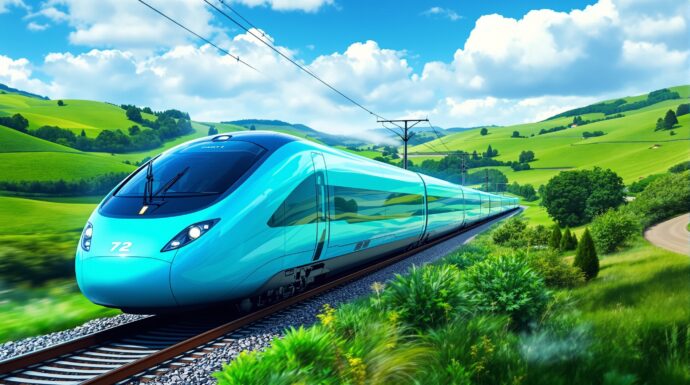
Ever wondered what the future of train travel looks like? Picture this: a sleek train gliding through the countryside, powered by the most abundant element in the universe, producing zero emissions, and leaving behind nothing but pure water vapour.
This isn’t a distant fantasy. It’s happening right now, on railway tracks across Germany, Japan, China, and soon in India. Welcome to the hydrogen railway revolution, a global movement that’s rewriting the rulebook on sustainable transportation.
Before we explore India’s ambitious plans (coming in Parts 2 and 3), let’s understand the technology that’s capturing the imagination of railway engineers worldwide and why countries are betting billions on hydrogen as the fuel of the future.
Berlin 2016: The Day Everything Changed
The story begins at InnoTrans 2016, the world’s leading trade fair for transport technology in Berlin. French rail manufacturer Alstom unveiled something extraordinary: the CORADIA iLint, a fully functional passenger train that ran entirely on hydrogen.
Painted in a distinctive turquoise blue, this wasn’t just a concept or prototype. It was a ready-for-service commercial train that promised to deliver everything diesel trains offered, zero emissions, quiet operation, and comparable performance, but without the pollution.
“The world’s first two hydrogen trains were developed by Alstom in Berlin, Germany. After successfully completing an 18-month trial in 2019, they proved hydrogen rail wasn’t science fiction it was railway science.”
Fast forward to today: Germany operates the world’s largest hydrogen train fleet with over 41 units running regular passenger services across regional lines, Alstom.
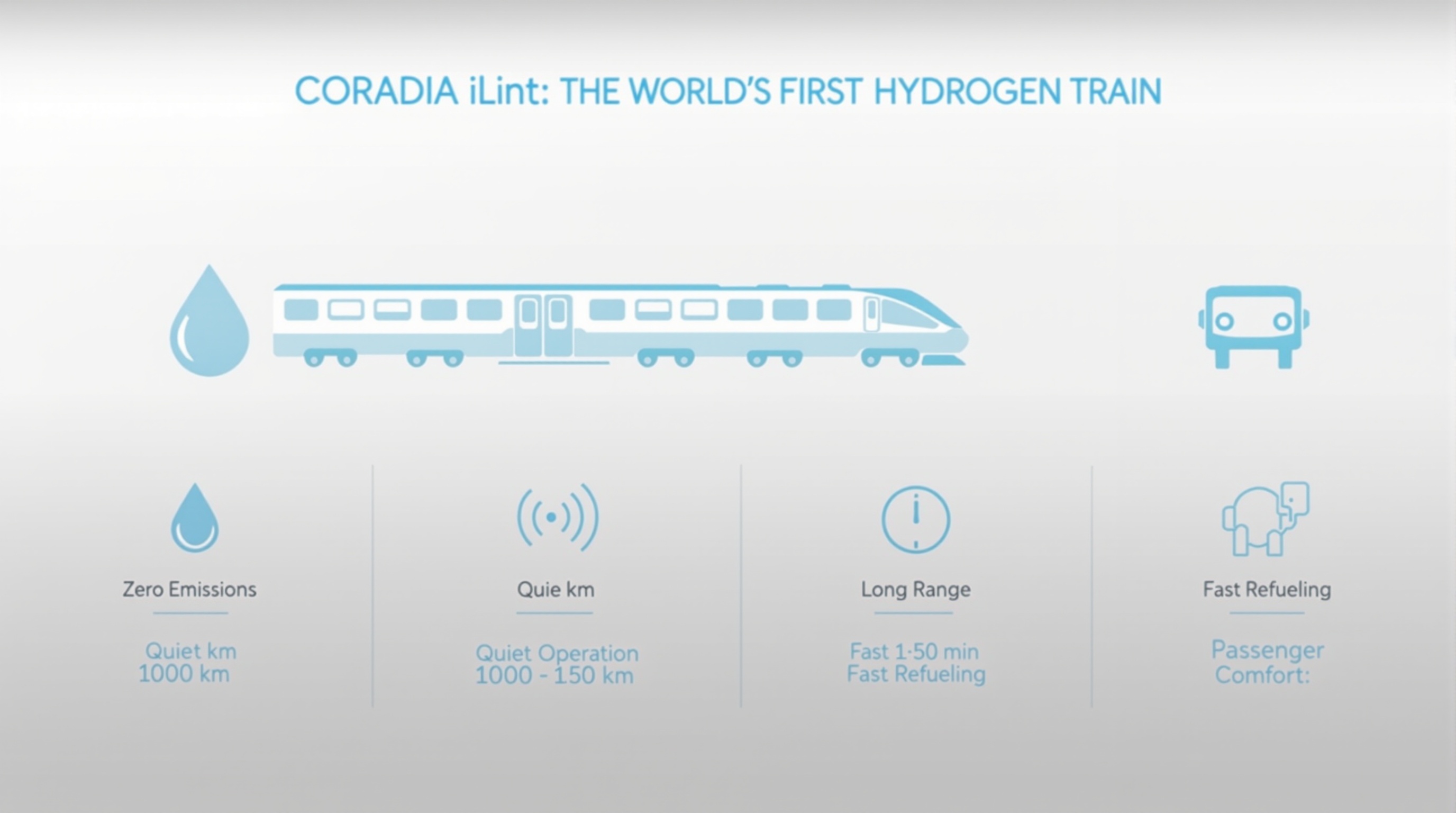
What Made Germany’s Hydrogen Train Special?
The CORADIA iLint didn’t just work on paper; it delivered real-world performance that matched diesel trains while eliminating emissions. Here’s what set it apart:
✅ Zero Direct Emissions – Only water and steam as byproducts
✅ Whisper-Quiet Operation – Dramatically reduced noise pollution
✅ Impressive Range – Up to 1,000 km on a single hydrogen tank
✅ Quick Refuelling – 15-20 minutes vs hours for battery charging
✅ Passenger-Ready – Same comfort and amenities as conventional trains
Germany’s journey hasn’t been entirely smooth. Recent reports indicate technical challenges with reliability in some units, a reminder that pioneering technology always comes with growing pains. But the fundamental viability has been proven: hydrogen trains work in real-world commercial service.
The Global Hydrogen Express: Who’s Racing Ahead?
Germany blazed the trail, but it’s no longer alone. A global hydrogen railway network is rapidly emerging, with major economies across three continents investing heavily in this technology.
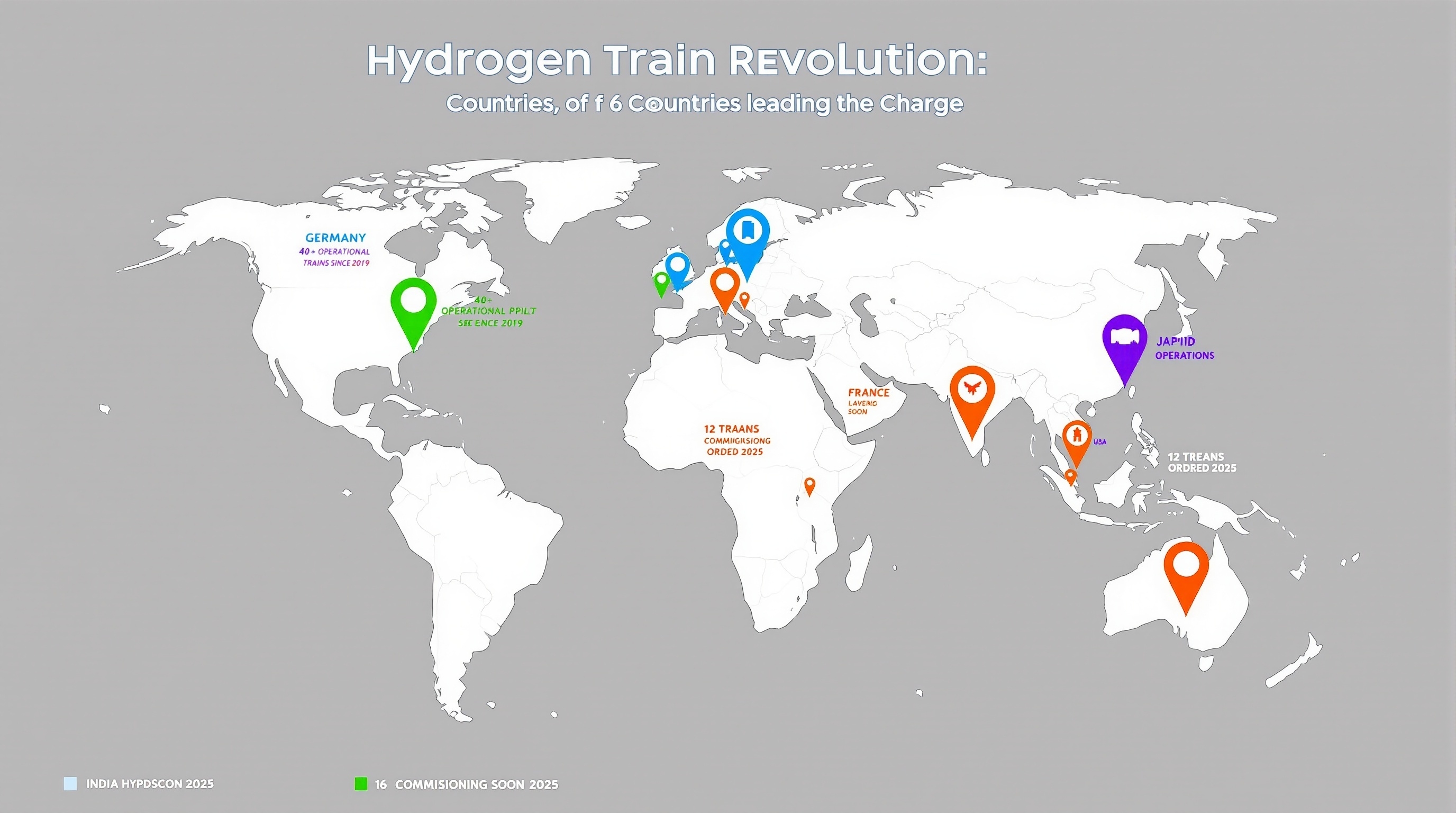
Let’s take a closer look at each country’s approach:
🇩🇪 Germany: The Pioneer (Since 2019)
Status: Fully Operational
Fleet Size: 40+ trains
Achievement: First country to prove commercial viability at scale
Routes: Regional passenger services across Lower Saxony and other states
Learning: Early technical challenges are being addressed in newer generations
🇯🇵 Japan: The Innovator (Since 2022)
Status: Advanced Pilot/Hybrid Development
Unique Approach: Hybari hybrid systems combining fuel cell + battery technology
Advantage: Leveraging decades of hydrogen expertise from the automotive sector (Toyota, Honda)
Focus: Perfecting technology before mass deployment
🇨🇳 China: The Scaler (Since 2022)
Status: Rapid Development/Operational
Strategy: Domestically-developed hydrogen engines for passenger AND freight
Scale: Moving quickly from pilot to commercial deployment
Goal: Manufacturing dominance in hydrogen rail technology globally
🇺🇸 United States: The Green State Leader (2025)
Status: Initial Operations
Flagship: Stadler FLIRT H2 operating in California
Context: Part of California’s ambitious zero-emission transportation mandate
Potential: Large non-electrified freight network could benefit from hydrogen
🇫🇷 France: The European Follower (Expected 2025)
Status: Ordered/Pilot Phase
Fleet: 12 hydrogen trains for regional routes
Strategy: Learning from Germany while developing French capabilities
Vision: Hydrogen as part of a comprehensive green mobility network
🇮🇳 India: The Heritage Focus (Commissioning Soon 2025)
Status: Final Testing Phase
Unique Angle: “Hydrogen for Heritage” 35 trains for UNESCO World Heritage mountain railways
Pilot: Sonepat-Jind route (89 km) in Haryana
Innovation: Cost-effective retrofitting approach rather than new purchases
The Chemistry of Clean: How Hydrogen Trains Actually Work
If you’re wondering what makes hydrogen such a revolutionary fuel, the answer lies in elegant chemistry that transforms the universe’s simplest element into clean, powerful energy.

The Fuel Cell Process: Turning Hydrogen into Motion
Here’s the magic happening inside a hydrogen train:
Step 1: Hydrogen gas (H₂) stored in high-pressure tanks onboard
Step 2: Oxygen (O₂) is drawn from the surrounding air
Step 3: Inside the fuel cell, hydrogen molecules split into protons and electrons
Step 4: Electrons flow through the circuit → creates electricity → powers the train
Step 5: Protons combine with oxygen → produce water vapour → only emission
Step 6: Waste heat captured for train heating/cooling systems
This is why hydrogen earns the title “cleanest fuel available.” The exhaust? Water vapor so pure you could theoretically drink it.
The Reverse Process: Making Green Hydrogen
An electrolyser works like a fuel cell in reverse:
Input: Water (H₂O) + Electricity (from solar/wind/hydro)
Output: Hydrogen (H₂) + Oxygen (O₂)
When that electricity comes from renewable sources, you get green hydrogen a completely carbon-free fuel cycle from production to use.
Anatomy of a Hydrogen Train: The Building Blocks
A hydrogen train is essentially a sophisticated orchestra of integrated systems working in harmony:
The Seven Essential Systems:
1. 🟢 Fuel Cells
The heart of the system, converting hydrogen + oxygen into electricity through an electrochemical reaction
2. 🔵 Hydrogen Storage Tanks
High-pressure cylinders (typically 350-700 bar) storing gaseous hydrogen, usually roof-mounted
3. 🟡 Li-Ion Battery Pack
Stores electrical energy, provides a boost during acceleration, and captures regenerative braking energy
4. 🟠 DC to AC Converter (Boost)
Transforms direct current from fuel cells into alternating current for traction motors
5. 🔴 Traction Converters
Control motor speed, torque, and power delivery for smooth acceleration and braking
6. 🟣 Three-Phase AC Motors
Actually drive the train’s wheels, powered by the electrical system
7. ⚫ Auxiliary Systems
HVAC (heating/cooling), lighting, doors, communications all the passenger comfort systems
This hybrid architecture combining fuel cells with batteries delivers the best of both worlds: hydrogen’s long range with batteries’ quick power response.
The Great Railway Fuel Debate: Hydrogen vs Electric vs Diesel
You might be wondering: if electric trains work perfectly well, why add the complexity of hydrogen? And how does it compare to familiar diesel technology?
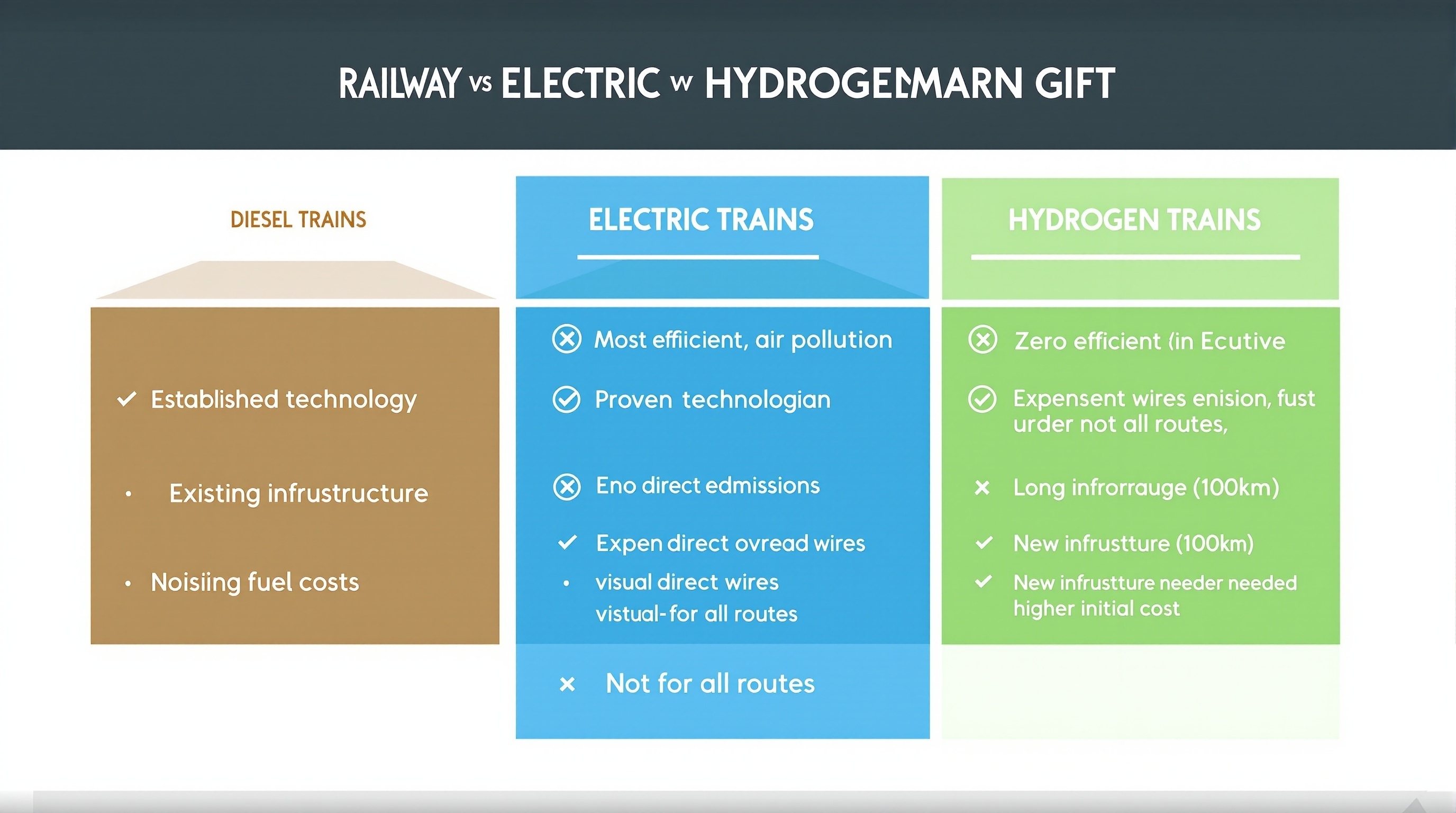
The Hydrogen Sweet Spot
According to research published on LinkedIn, hydrogen fuel cell technology achieves 50-60% energy conversion efficiency, significantly higher than diesel engines and includes regenerative braking systems that diesel trains completely lack.
Where Hydrogen Trains Excel:
✅ Non-electrified routes where overhead wire installation costs ₹4-5 crore per km
✅ Heritage and scenic railways where preserving visual aesthetics is crucial
✅ Mountain routes where electrification faces technical challenges
✅ Medium-distance routes (100-800 km) where range advantages matter
✅ Environmentally sensitive areas where zero emissions are mandated
✅ Tourist destinations where clean, quiet operation enhances the experience
Where Electric Trains Still Win:
For fully electrified mainline routes with heavy traffic, overhead electric trains remain the most energy-efficient choice. But that leaves approximately 45% of global railway routes that aren’t electrified, where hydrogen offers a compelling zero-emission alternative.
The Colour Spectrum of Hydrogen: Not All H₂ is Created Equal
Here’s a crucial nuance often overlooked in hydrogen enthusiasm: hydrogen is only as clean as the energy used to produce it.
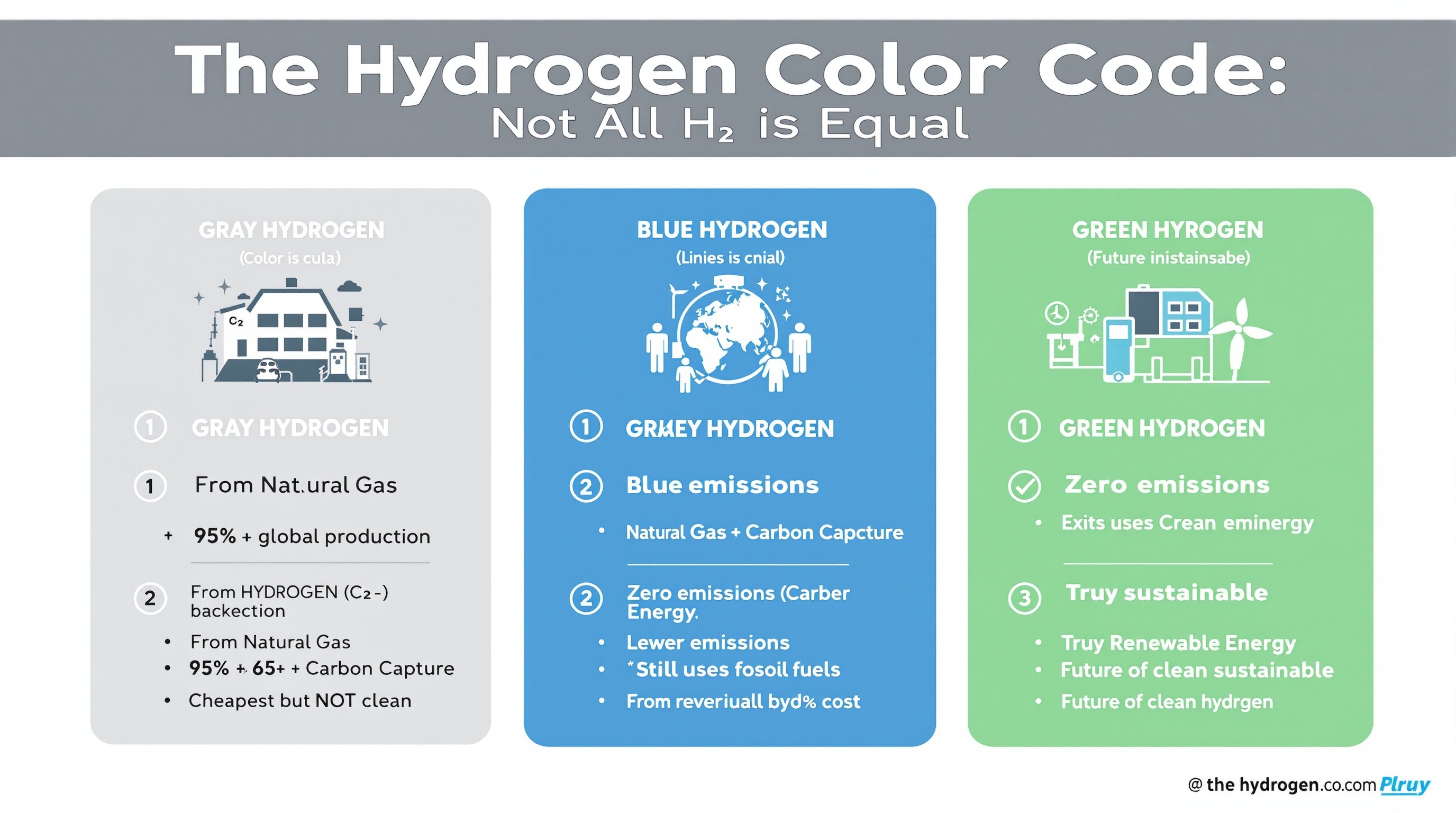
Understanding the Hydrogen Rainbow:
🌫️ Grey Hydrogen – The Problem
Made from natural gas (methane reforming), this accounts for 95% of today’s hydrogen production. It’s cheap but defeats the entire purpose of “clean” trains by emitting CO₂ during production.
💙 Blue Hydrogen – The Compromise
Also made from natural gas, but with carbon capture technology to reduce emissions. Better than grey, but still reliant on fossil fuels and not truly zero-emission.
💚 Green Hydrogen – The Goal
Produced using renewable electricity (solar, wind, hydro) to split water. Zero emissions throughout the entire lifecycle. Currently more expensive, but costs are falling rapidly as renewable energy and electrolyser technology advance.
For hydrogen trains to fulfill their environmental promise, they must run on green hydrogen. This is where policy, infrastructure investment, and renewable energy expansion become absolutely crucial.
Germany’s Real-World Lessons: What Six Years Taught Us
Germany’s six-year experience with commercial hydrogen train operations offers invaluable insights for countries like India preparing to launch their own programs.
✅ What Worked Well:
Passenger Acceptance – High satisfaction with quiet, smooth rides and a clean experience
Environmental Impact – Measurable reductions in emissions and noise on converted routes
Operational Range – 1,000 km range met requirements without range anxiety
Refuelling Efficiency – Fast turnaround times kept trains on schedule
Schedule Integration – Hydrogen trains integrated seamlessly into existing timetables
⚠️ Challenges Encountered:
Technical Reliability – Some maintenance issues with first-generation units
Supply Chain – Hydrogen production and distribution complexities
Operating Costs – Initially higher than diesel (though decreasing)
Specialised Training – Need for maintenance staff skilled in hydrogen systems
Weather Sensitivity – Some performance variations in extreme conditions
💡 Key Takeaway:
First-generation technology always has teething problems. But the fundamental viability of hydrogen trains has been proven beyond doubt. Second and third-generation designs are addressing current limitations, and costs are coming down as production scales.
The Infrastructure Challenge: Building the Hydrogen Ecosystem
Running hydrogen trains requires more than just buying locomotives. It demands an entire supporting ecosystem:
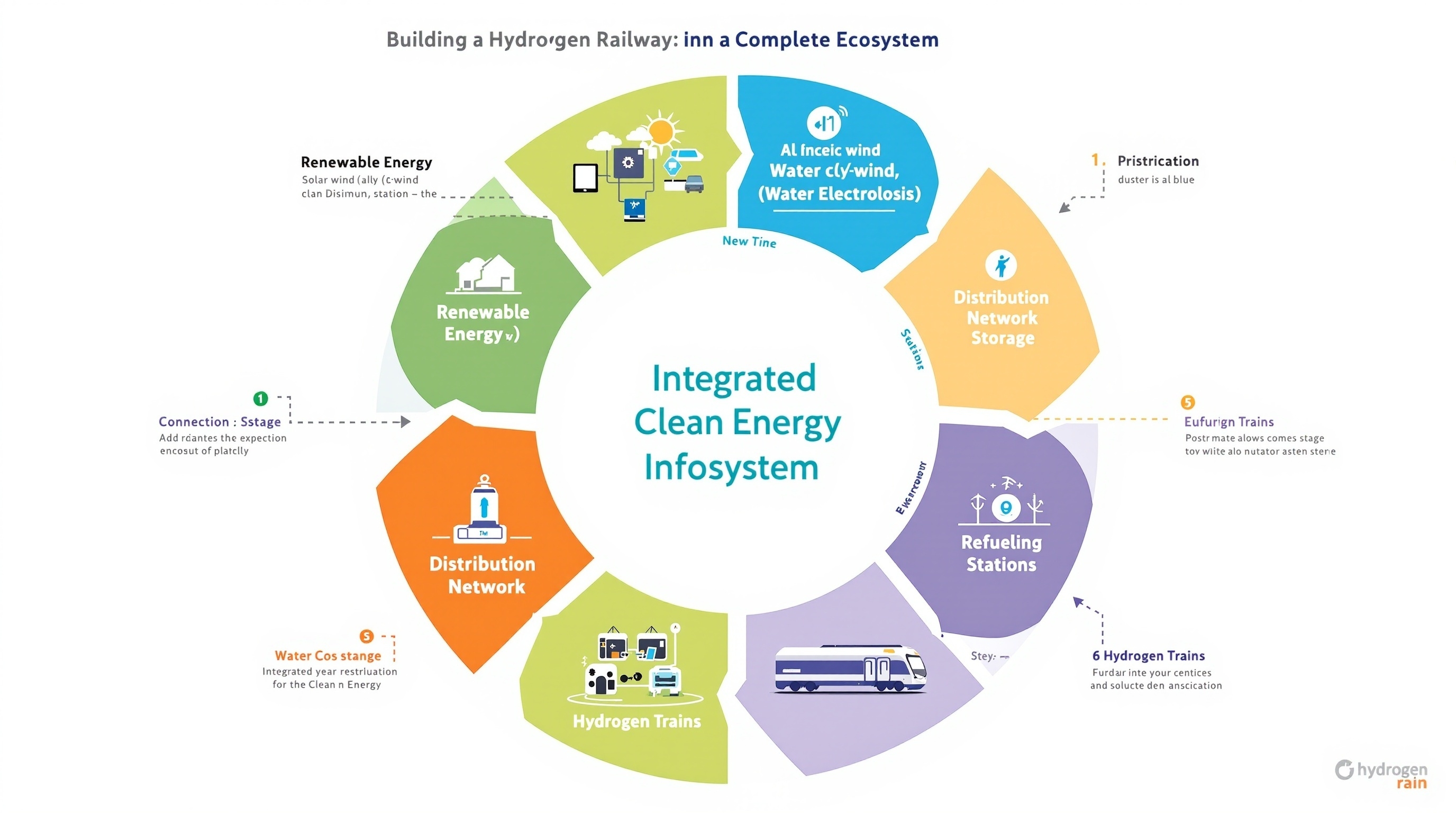
The Six Essential Components:
1. ☀️ Renewable Energy Generation
Solar farms, wind turbines, or hydroelectric plants provide clean electricity
2. 💧 Hydrogen Production (Electrolysis)
Electrolysers split water into hydrogen and oxygen using renewable power
3. 🗜️ Storage Infrastructure
High-pressure tanks or liquefaction facilities for storing produced hydrogen
4. 🚛 Distribution Network
Pipelines or specialised trucks transporting hydrogen to refuelling stations
5. ⛽ Refueling Stations
Railway depots equipped with hydrogen dispensing equipment and safety systems
6. 🚂 Hydrogen Train Operations
The trains themselves, plus maintenance facilities and trained staff
This integrated system requires significant upfront investment but creates a one-time infrastructure that serves trains for decades, exactly like traditional railway electrification.
What’s Next: The Future Trajectory
The global hydrogen train movement stands at a pivotal moment. We’ve graduated from proof-of-concept to commercial deployment. The next decade will determine whether hydrogen becomes mainstream railway technology.
Trends Shaping the Future:
Mass Production Scaling – Manufacturers ramping up to bring costs down through economies of scale
Green Hydrogen Expansion – Massive renewable energy projects specifically tied to hydrogen production
Hybrid Innovations – Next-gen designs optimally combining hydrogen fuel cells with advanced batteries
Freight Applications – Heavy hydrogen locomotives for cargo transport under development
International Standards – Global cooperation on safety standards, specifications, and technology sharing
Cost Reduction Curve – Projected 60-70% cost decrease by 2030 as technology matures
That’s the global hydrogen train revolution in a nutshell.
This is Part 1 of a three-part series on hydrogen trains. Continue reading Part 2: India’s Hydrogen Train Pioneer:, we’ll explore India’s unique approach, including the groundbreaking Sonepat-Jind pilot project and why Indian Railways chose to start with heritage routes | Part 3: Economics & Timeline, we’ll dive deep into the economics, challenges, and timeline for India’s hydrogen railway future.
This article is based on insights shared at the 18th Urban Mobility India Conference & Exhibition, held in Gurugram. For more stories on sustainable urban mobility and policy analysis, stay tuned to Urban Voices.
